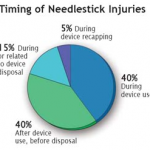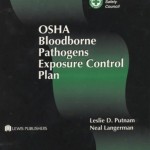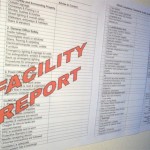The mission of the Occupational Safety and Health Administration (OSHA) is to save lives, prevent injuries, and protect the health of America’s workers. As part of the Department of Labor, OSHA and the states that operate OSHA-approved state plans establish guidelines and standards to promote worker safety and health that apply to every workplace in the United States, including medical and dental offices.
This article provides only a glimpse of the most frequently found hazards in medical and dental offices. Many other standards may apply. This information should not be used as a substitute for reading and becoming familiar with all applicable OSHA standards. As an employer, it is up to you to follow up and obtain the full text of the OSHA standards, all of which are available on the OSHA website at www.osha.gov or by calling the toll free number (800) 321-OSHA (6742). Most OSHA materials are available at no charge.
The following requirements include those that normally apply to medical and dental offices, whether there are 2 or 200 employees. Additional OSHA standards may apply to some offices. The complete text of the regulations can be found in Title 29 of the Code of Federal Regulations (29 CFR).
Bloodborne Pathogens Standard
(29 CFR 1910.1030)
This is the most frequently requested and referenced OSHA standard affecting medical and dental offices. Some basic requirements of the OSHA Bloodborne Pathogens standard include:
- A written exposure control plan, to be updated annually
- Use of universal precautions
- Consideration, implementation, and use of safer, engineered needles and sharps
- Use of engineering and work practice controls and appropriate personal protective equipment (gloves, face and eye protection, gowns)
- Hepatitis B vaccine provided to exposed employees at no cost
- Medical follow-up in the event of an “exposure incidentâ€
- Use of labels or color-coding for items such as sharps disposal boxes and containers for regulated waste, contaminated laundry, and certain specimens.
- Employee training.
- Proper containment of all regulated waste
Hazard Communication
(29 CFR 1910.1200)
 The hazard communication standard is sometimes called the “employee right-to-know†standard. It requires employee access to hazard information. The basic requirements include:
The hazard communication standard is sometimes called the “employee right-to-know†standard. It requires employee access to hazard information. The basic requirements include:
- A written hazard communication program
- A list of hazardous chemicals (such as alcohol, disinfectants, anesthetic agents, sterilants, mercury) used or stored in the office
- A copy of the Material Safety Data Sheet (MSDS) for each chemical (obtained from the manufacturer) used or stored in the office
- Employee training
Ionizing Radiation
(29 CFR 1910.1096)
This standard applies to facilities that have an x-ray machine and requires the following:
- A survey of the types of radiation used in the facility, including x-rays
- Restricted areas to limit employee exposures
- Employees working in restricted areas must wear personal radiation monitors such as film badges or pocket dosimeters
- Rooms and equipment may need to be labeled and equipped with caution signs
Exit Routes
(29 CFR Subpart E 1910.35, 1910.36, 1910.37, and 1910.38 and 1910.39)
 These standards include the requirements for providing safe and accessible building exits in case of fire or other emergency. It is important to become familiar with the full text of these standards because they provide details about signage and other issues. OSHA consultation services can help or your insurance company or local fire/police service may be able to assist you. The basic responsibilities include:
These standards include the requirements for providing safe and accessible building exits in case of fire or other emergency. It is important to become familiar with the full text of these standards because they provide details about signage and other issues. OSHA consultation services can help or your insurance company or local fire/police service may be able to assist you. The basic responsibilities include:
- Exit routes sufficient for the number of employees in any occupied space
- A diagram of evacuation routes posted in a visible location.
Electrical
(Subpart S-Electrical 29 CFR 1010.301 to 29 CFR1910.399)
These standards address electrical safety requirements to safeguard employees. OSHA electrical standards apply to electrical equipment and wiring in hazardous locations. If you use flammable gases, you may need special wiring and equipment installation. In addition to reading the full text of the OSHA standard, you should check with your insurance company or local fire department, or request an OSHA consultation for help.
OSHA Poster
Every workplace must display the OSHA poster (OSHA Publication 3165), or the state plan equivalent. The poster explains worker rights to a safe workplace and how to file a complaint. The poster must be placed where employees will see it. You can download a copy or order one free copy from OSHA’s web site at www.osha.gov or by calling (800) 321-OSHA.
Reporting Occupational Injuries and Illnesses
(29 CFR 1904)
Medical and dental offices are currently exempt from maintaining an official log of reportable injuries and illnesses (OSHA Form 300) under the federal OSHA recordkeeping rule, although they may be required to maintain records in some state plan states. If you are in a state plan state, contact your state plan directly for more information. All employers, including medical and dental offices, must report any work-related fatality or the hospitalization of three or more employees in a single incident to the nearest OSHA office. Call (800) 321OSHA or your state plan for assistance.
Helpful Resources
OSHA makes every effort to make information about its regulatory requirements readily available to the public. The full text for each standard in this brochure is available on the OSHA website at www.osha.gov. You can search for a specific subject by using the alphabetic index near the top of the home page or by clicking on Laws and Regulations under Compliance Assistance, then clicking on OSHA Regulations (Standards-29CFR).
A new OSHA publication, Model Plans and Programs for the OSHA Bloodborne Pathogens and Hazard Communications Standards, contains models of these two important documents that can be tailored to your business or office. Request Publication 3186-06N to receive this helpful resource. Information on other areas of interest or concern, such as compresssed gases, may be obtained by calling OSHA.
The OSHA toll-free number is (800) 321-OSHA. Operators will direct the caller to the appropriate federal or state plan office office to request a consultation, file a complaint, report a fatality, provide telephone numbers to OSHA offices and the OSHA-approved state plan programs. They also take orders for OSHA publications.
